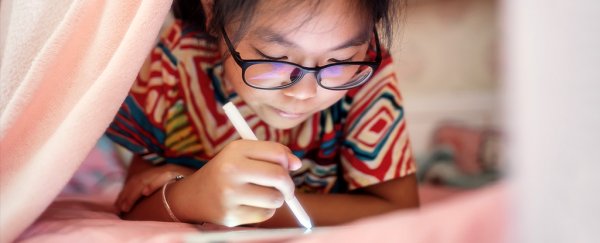There's a whole lot of consequences from the current global pandemic that we didn't see coming, and worsening eyesight among children might be one of them.
Over the course of last year, researchers in Hong Kong detected a rapid rise in shortsightedness, or myopia, among 709 children between the ages of 6 and 8.
Compared to previous years, diagnosed cases of myopia rose by more than 10 percent, impacting nearly a fifth of the cohort studied.
While it's impossible to say from the data whether this loss of distant eyesight is directly linked to the pandemic, spending time outdoors is known to lower a child's risk of developing shortsightedness, while doing 'near work' such as reading, writing, or looking at screens tends to increase the risk.
In fact, recent research suggests lack of outdoor time might be a bigger indicator of myopia than even genetics. It's therefore possible that school closures and widespread lockdowns, brought on by the pandemic, are to blame for the recent rise in shortsightedness among children.
"Although household quarantining and school closures against the pandemic will not last forever, the increasing adoption of and reliance on digital devices, as well as behavioral changes resulting from extended home confinement, may have long-lasting effects on myopia progression in the population, especially among children," researchers write in their new paper.
Today in China myopia is considered an epidemic. Over 90 percent of young people there are shortsighted, leaving the next generation susceptible to multiple eye conditions over the course of their lives.
Each year, hundreds of thousands of school students in China undergo an eye test to track this widespread condition. Similar to recent results from Hong Kong, this national eye program has also revealed a significant uptick in myopia on the mainland.
According to recently published data, the prevalence of shortsightedness among 6-year-old children in China was three times higher during the 2020 lockdowns.
"This substantial myopic shift was not seen in any other year-to-year comparison, making the cause possibly due to the unusual occurrence of home confinement in 2020," reads the report, which was published earlier this year.
Results in Hong Kong tracking myopia during COVID-19 now support these findings.
"The myopia incidence (13.15% over 1 year) in the previous cohort was lower than that of our COVID-19 cohort (19.44% over 8 months, pstates in the paper.
It's still not clear what exactly is driving this increase, but questionnaires have revealed children in Hong Kong spent 68 percent less time outdoors during the pandemic, going from an hour and a quarter of outdoor time, on average, to a mere 24 minutes a day.
Time spent staring at screens, on the other hand, increased by nearly 3-fold, rising from 2.5 hours a day, on average, to a whopping 7 hours a day.
Kids living in Hong Kong already spend significantly less time outdoors compared to elsewhere in the world. In this dense city, there's just not a lot of fresh air to play in, and the pandemic only made that problem worse.
During COVID-19, not only did schools and playgrounds close, so too did pools, parks, campsites and indoor recreational activities like gyms and gaming arcades.
As such, children in Hong Kong had little choice but to stay indoors. Due to the compounding factors of outdoor time and increased near work, it's possible the shape of their eyes has changed over the course of the eight month study, throwing off their focus and causing distant objects to blur.
"Although no clear association was found between screen time and myopia progression, screen time itself is a form of near work," the authors explain.
"[I]ncreased screen time therefore might have contributed to myopia progression during the current period of quarantine."
The research is only based on observational data, and screen time and outdoor time were self-reported. Despite these limitations, the findings join a growing body of research that suggests the global pandemic is increasing time spent on near work, which, in turn, increases the risk of myopia.
"Despite all these insurmountable study limitations, our initial results still show an alarming myopia progression that warrants appropriate remedial action," the authors write.
The study was published in the British Journal of Ophthalmology.
